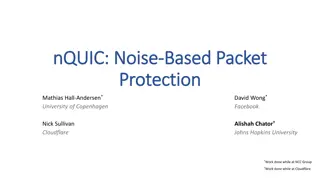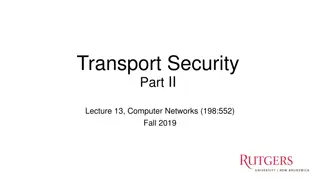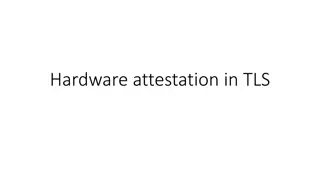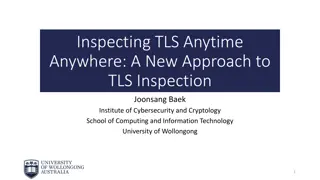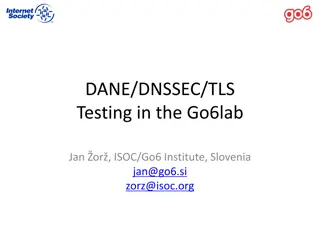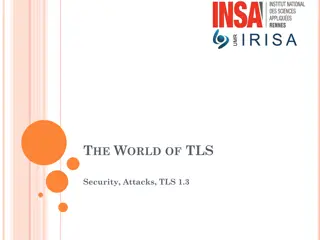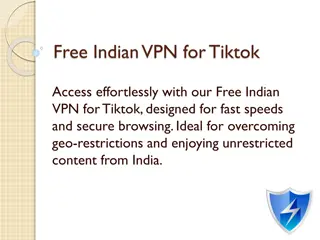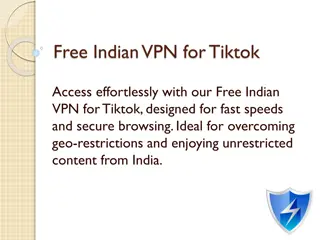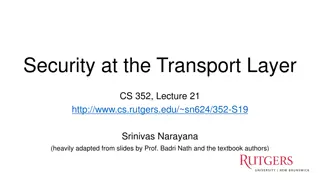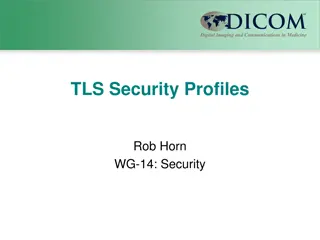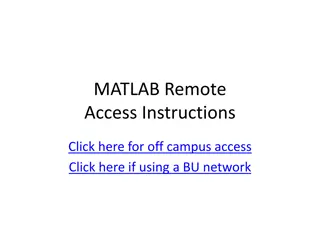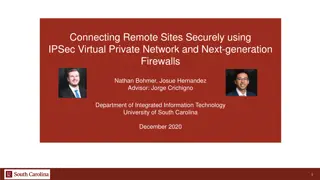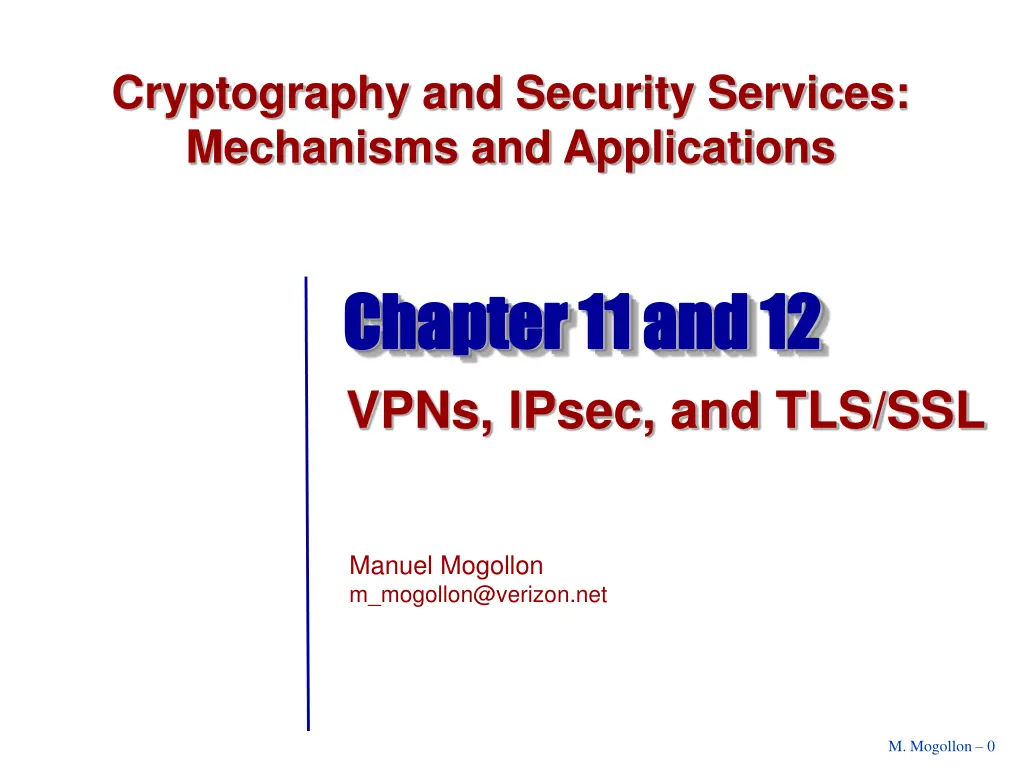
Implementing Secure VPNs in Modern Networking Environments
Learn about Virtual Private Networks (VPNs) and the importance of secure data communication channels over public IP networks. Explore the use of IPsec, TLS/SSL, and other mechanisms for ensuring the confidentiality and integrity of network communications in various business settings.
Download Presentation

Please find below an Image/Link to download the presentation.
The content on the website is provided AS IS for your information and personal use only. It may not be sold, licensed, or shared on other websites without obtaining consent from the author. If you encounter any issues during the download, it is possible that the publisher has removed the file from their server.
You are allowed to download the files provided on this website for personal or commercial use, subject to the condition that they are used lawfully. All files are the property of their respective owners.
The content on the website is provided AS IS for your information and personal use only. It may not be sold, licensed, or shared on other websites without obtaining consent from the author.
E N D
Presentation Transcript
Cryptography and Security Services: Mechanisms and Applications Chapter 11 and 12 Chapter 11 and 12 VPNs, IPsec, and TLS/SSL Manuel Mogollon m_mogollon@verizon.net M. Mogollon 0
Session 9 Contents VPNs Tunneling IPsec Layer 2 Tunneling Protocol (L2TP) TLS/SSL VPN IPsec IKE v2 TLS M. Mogollon 1
TCP/IP Stack and Security Related Protocols S/MIME S-HTTP PGP SET SMTP, Telnet, FTP, Gopher Application Layer IPsec (ISAKMP) SOCKS V5 TLS/SSL Transport Layer TCP UDP IPsec (AH, ESP) Network Layer IP ARP RARP Packet Filtering Tunneling Protocols Ethernet, Token-Ring, FDDI, X.25, Wireless, Async, ATM, SNA...Data Layer PPP-EAP, IEEE 802.1X, CHAP, PAP, MS-CHAP Data Layer VPN IPsec IKE v2 TLS M. Mogollon 2
What is a Virtual Private Network? VPNs / Private data communication channels that use a public IP network, i.e., Internet, as the basic transport for connecting corporate data centers, remote offices, mobile employees, telecommuters, customers, suppliers, and business partners. The public network is used as a wide area communications network, and it offers the appearance, functionality, and usefulness of a dedicated private network. VPN IPsec IKE v2 TLS M. Mogollon 3
E-Commerce, E-Procurement, E-Care Business Partners Mobile Workforce Headquarters Internet Suppliers Customers Telecommuters Contractors But, the Internet is a public network and it doesn t have any security! VPN IPsec IKE v2 TLS M. Mogollon 4
Secure VPNs Security is implemented in all products that offer VPNs. Secure VPNs are revolutionizing the way the Internet is used. IETF has standardized IPsec (IP Security) for secure VPN applications that have the following features: are transparent to all TCP/IP applications can be implemented in any LAN/WAN environment using TCP/IP can secure any business communication over the Internet. IPsec is a mandatory part of the forthcoming IPv6 standard. VPN IPsec IKE v2 TLS M. Mogollon 5
Implementation of VPNs Located at the carrier s network In the first scenario, the service provider provides a service similar to the public switched Frame Relay or ATM service, and the customer trusts that packets will not be misdirected, modified in transit, or subjected to traffic analysis by unauthorized parties. On the customer s premises In the second scenario, the customer does not trust the service provider and implements a VPN using CPE equipment that provides firewall functionality and security. Any devices with microprocessors, such as routers, servers, firewalls or even PCs, can perform VPN functions, such as creating tunnels and encrypting packets. VPN IPsec IKE v2 TLS M. Mogollon 6
Secure VPN Business Partners Mobile Workforce Headquarters Internet Suppliers Customers Contractors VPNs Telecommuters With Secure VPNs, I am sure to whom I am talking. I know my message has not been modified. I know that only authorized persons have seen my message. I know that the message recipient can t deny receiving my message. VPN IPsec IKE v2 TLS M. Mogollon 7
VPN Applications: Extranets and Remote Access Security Policy Server Security Policy Server Internet Server Tunnel Mode Gateway Protected Subnet Protected Subnet Mobile Workforce with IPsec Client Software Certificate Authority Tunnel Mode Authentication is provided between a client and a corporate VPN device, or between two VPN devices. Transport Mode Authentication is provided directly between a client and a server or between two work stations. VPN IPsec IKE v2 TLS M. Mogollon 8
Virtual Private Networks (VPN) Network of virtual circuits for carrying private traffic. VPN Protocols PPP L2TP IPsec Mode Client-server Client-server Host-to-Host Purpose OSI layer Remote access via tunneling Layer 2 Remote access via tunneling Layer 2 Intranets, extranets, remote access via tunneling Layer 3 TCP/IP Layer Data Data Network Protocol IP, IPX, AppleTalk, etc IP, IPX, AppleTalk, etc IP PPP and L2TP are aimed at remote access use. IPsec is used for connecting LANs. VPN IPsec IKE v2 TLS M. Mogollon 9
VPN Benefits Ease of use Facilitating electronic communications makes corporations more efficient and productive. Cost Eliminating long-haul leased lines, 800 numbers or long distance fees, modem banks, and multiple access connections results in significant savings. Voice over IP reduces long distance phone call expenses. Savings of up to 65% on monthly circuit costs by moving from a FR and ATM environment to an IP VPN Teleworker lower connection costs by 20%-25% per month over traditional dial up & ISDN. Use of Standard Protocols Internet Protocol IP and IPsec provide needed standardization. Simplification of Maintenance and Support Reducing scalability issues and management complexity simplifies network operation. VPN IPsec IKE v2 TLS M. Mogollon 10
What is IPsec? IPsec / (1) A suit of security protocols standardized by the Internet Engineering Task Force (IETF) that address data privacy, integrity, authentication, and key management, as well as, tunneling to TCP/IP networks. (2) A secure architecture that supports several applications that encrypt and/or authenticate all traffic at the IP level. VPN IPsec IKE v2 TLS M. Mogollon 11
Why IPsec IPsec-compliant products allow secure Virtual Private Networks in any existing IP-based network. IPsec is based on several strong encryption standards. IPsec provides security services such as: data origin authentication, access control, confidentiality (encryption), connectionless integrity, rejection of replayed packets (a form of partial sequence integrity), and limited traffic flow confidentiality. IPsec has government and industry support. IPsec allows corporations to select security services according to internal security policies. VPN IPsec IKE v2 TLS M. Mogollon 12
Internet Protocol (IP) Security Threats Attacks include: IP Spoofing Packet Sniffing Session Hijacking Man-in-the-Middle The Internet protocol has no security. Source/destination address & port IP Packet Various IP Header Fields Upper Protocol Header (i.e., TCP, UDP, ICMP) Source IP Address Destination IP Address Data IP Header TCP Data IP Header Payload Data VPN IPsec IKE v2 TLS M. Mogollon 13
IPsec Interlocking Technologies Cryptographic Security Mechanisms for IP Authentication Header (AH) Provides integrity and authentication without confidentiality to IP datagrams. Available even in locations where the export, import or use of encryption to provide confidentiality is regulated. Encapsulation Security Payload (ESP) Provides integrity, authentication, and confidentiality to IP datagrams. Key Management Internet Key Exchange IKEv2 Allows users to agree on authentication methods, encryption methods, keys to use, and key duration. Key exchange could be manual or automated. VPN IPsec IKE v2 TLS M. Mogollon 14
IP Security Architecture IP Packets IPsec Databases Security Policy Database (SPD) Security Association Database (SAD) Peer Authorization Database (PAD) Security Associations Information shared between two Gateways on how to secure communications. IPsec Databases (SPD, SAD, PAD) ESP/AH Engine Security Protocols AH is used to authenticate. ESP is used to encrypt and to authenticate. Encapsulation Security Payload Protocol Authentication Header Protocol Algorithms for encryption and authentication Symmetric encryption algorithms. Keyed hash algorithms. Authentication & Integrity Algorithms Encryption Algorithm Key Management Protocols Manual and Automated Key Management VPN IPsec IKE v2 TLS M. Mogollon 15
Security Protocols IPsec provides mechanisms to provide security services to IP and upper layer protocols (e.g., UDP or TCP). IPsec protect IP datagrams by defining a method in a SA. The SA associated with a connection could be Encapsulating Security Payload (ESP), or Authentication Header (AH), but not both. If both AH and ESP protection are applied to a connection, then two (or more) SAs are created to provide protection to the connection. To secure typical, bi-directional communication between two hosts, or between two security gateways, two Security Associations (one in each direction) are required. Both ESP and AH security protocols support two modes of operation: transport or tunnel mode. VPN IPsec IKE v2 TLS M. Mogollon 16
IPsec Negotiation Applications Applications Negotiator Engine Negotiator Engine IPsec Databases (SAD, PAD) IPsec Databases (SAD, PAD) 5 1 SA Attributes TCP/IP TCP/IP 6 4 2 2 SPI 3 Unprotect- Protect Engine Unprotect- Protect Engine Security Policy Database Security Policy Database 1 Outbound IPsec Packet Inbound IPsec Packet VPN IPsec IKE v2 TLS M. Mogollon 17
IPsec Document Roadmap IP Security Architecture RFC 4301 AH Protocol RFC 4302 ESP Protocol RFC 4303 IKE v2 RFC 4306 Encryption Algorithms RPC 3602 (AES-CBC (128-Bit) RFC 3686 (AES-CTR) RFC 2451 (Triple DES-CBC) Authentication Algorithms RFC 3566 (AES-XCBC-MAC-96) RFC 2404 (HMAC-SHA1-96) RFC 2403 (HMAC-MD5-96) Key Management RFC 4120 (Kerberos) RFC 2093 (GKMP) RFC 2412 (OAKLEY) VPN IPsec IKE v2 TLS M. Mogollon 18
AH and ESP Modes of Operation Tunnel Transport VPN Device VPN Device Server Client AH ESP Inner IP Header Outer IP Header Outer IP Header Confidentiality New IP Header Header ESP Original IP Header Payload Data New IP Header Header AH Original IP Header Payload Data Tunnel Mode Authentication / Integrity Authentication / Integrity Inner IP Header Inner IP Header Confidentiality Payload Data Original IP Header Header ESP Payload Data Original IP Header Header AH Transport Mode Authentication / Integrity Authentication / Integrity VPN IPsec IKE v2 TLS M. Mogollon 19
Authentication Header (AH) Authentication Data Algorithms HMAC-SHA-1-96 (Must be supported) AES-XCBC-MAC-96 (Should be supported) HMAC-MD5-96 (May be supported) Data Integrity: Undetected modification to a packet s content in transit is not possible Authentication: Enables a network device to authenticate a user. Anti-replay service (optional) Authentication IP Header AH Payload Data 8 bits 8 bits 16 bits Next Header AH Payload Length Reserved Word 1 Security Parameters Index (SPI) Word 2 Sequence Number Word 3 Integrity Check Value ICV (variable) Word 4 - 32 bits VPN IPsec IKE v2 TLS M. Mogollon 20
Encapsulation Security Payload (ESP) Data Integrity + Authentication (optional) Anti-replay Service (optional) Confidentiality (optional) Authentication Encryption Original IP Header ESP Header Payload Data ESP Trailer ESP ICV Security Parameters Index (SPI) Sequence Number Payload Data (variable) Padding (0 255 bytes) Pad Length Next Header Integrity Check Value ICV (variable) 8 bits 8 bits 32 bits VPN IPsec IKE v2 TLS M. Mogollon 21
Internet Key Exchange (IKE v2) IPsec security services use symmetric encryption. Source and destination need to agree to the mechanisms used to share the secret keys and the keys that are used for authentication/integrity and encryption services. IPsec supports both manual and automatic distribution of keys. Public Key is used for automatic key management, but other automated key distribution techniques may be used. IKE v2 defines procedures and packet formats to establish, negotiate, modify, and delete Security Associations (SA). VPN IPsec IKE v2 TLS M. Mogollon 22
Negotiating a Security Association using IKE IKE Security Association (IKE SA) proposes the following: Type of protection to use, either ESP or AH. Authentication algorithms and keys for signing data. Encryption algorithms and keys to protect data. Hash algorithms to reduce data for signing. Information about a group over which to do a Diffie- Hellman exchange. A pseudo-random function (prf) to hash certain values during the key exchange. VPN IPsec IKE v2 TLS M. Mogollon 23
Security Association I would like to establish a secure IP communication, and since we haven t talked before, let s agree on all the security parameters we need by creating an SA. Destination Once we finish, let s assign an index to the SA, (Security Parameter Index) and store the information in our Security Policy Databases. By doing this, we will not have to create another SA when we communicate again. Source Security Parameters Encryption and authentication algorithms Encapsulation Security Payload (ESP) Authentication Header (AH) Crypto keys Initialization values Protocol mode Source and destination IP addresses Source and destination IDs Key lifetimes VPN IPsec IKE v2 TLS M. Mogollon 24
Internet Key Exchange (IKE) First Message Exchange IKE Security Association In IKE_SA_INIT, the initiator and responder negotiate the use of encryption algorithms by establishing an IKE_SA. The agreed keys are used to protect the IKE_AUTH exchange. In IKE_AUTH, the initiator and responder authenticate each other using authentication mechanisms such as digital signatures (exchanging certificates), Extensible Authentication Protocol (EAP), or pre-shared keys. Child Security Association In IKE_AUTH, the first IKE_SA and associated IPsec SA, called child SA, are created. Second Message Exchange CREATE_CHILD_SA exchange is used to create new CHILD_SAs and to rekey IKE_SAs and CHILD_SAs. All messages are cryptographically protected using the encryption algorithms and keys negotiated in IKE_SA_INIT and IKE_SA_AUTH. VPN IPsec IKE v2 TLS M. Mogollon 25
IKE First Message Exchange I would like to establish an IKE security association and a child security association. Initiator Responder Networking Device with IPsec End -system or Gateway environment Networking Device with IPsec End -system or Gateway environment 1 Ni KEi SAi1 HDR 2 SAr1 KEr Nr [CERTREQ] HDR 3 SK{IDi, [CERT], [CERTREQ], [IDr], AUTH, SAi2, TSi, TSr} HDR 4 SK{IDr, [CERT], AUTH, SAr2, TSi, TSr} HDR AUTH Authentication HDR IKE Header IDr Responder Identification Ni, Nr Nonce SAi1 , SAr1 Used to create IKE_SA SAi2, SAr2 Used to create the first CHILD_SA SK{ .} Payload is encrypted and integrity protected using SK_e and SK_a. CERT Certificate i, r Initiator, Responder KEi Initiator DH gi SA - Security Association CERTREQ Certificate Request IDi - Initiator Identification KEr Responder DH gi TSi, TSr Traffic Selector VPN IPsec IKE v2 TLS M. Mogollon 26
IKE Second Message Exchange I would like to generate a new Child_SA or rekey IKE SA and/or a previous Child_SA. Initiator Responder Networking Device with IPsec End -system or Gateway environment Networking Device with IPsec End -system or Gateway environment 5 SK{ [N+], SA, Ni, [KEi], TSi, TSr} HDR 6 SK{ [N+], SA, Nr, [KEr], TSi, TSr} HDR HDR IKE Header [KE] Optional Key Exchange [N+] Optional Notify Ni, Nr Nonce TSi, TSr Traffic Selector SK{ .} Payload is encrypted and integrity protected using SK_e and SK_a. i, r Initiator, Responder SA - Security Association VPN IPsec IKE v2 TLS M. Mogollon 27
IKE v2 Header IKE_SA Initiator s Security Parameters Index (SPI) IKE_SA Responder s Security Parameter Index (SPI) Next Payload MjVer MjVer Exchange Type Flags Message ID Length Initiator s SPI (8 Octets) A value selected by the initiator to identify a unique IKE security association. Responder s SPI (8 Octets) A value selected by the responder initiator to identify a unique IKE security association. This value is zero in the first message of the IKE_INIT. Next Payload (1 Octet) the type of payload that follows the header. Major Version (4 bits) The major version of the IKE protocol used. Minor Version (4 bits) The minor version of the IKE protocol used. Exchange Type (1 Octet) The type of exchange being use, IKE_INIT, IKE_AUTH, CREATE_CHILD_SA, or INFOTMATIONAL. Flags (1 Octet) Indicates specific options that are set for the message. Message ID (4 Octets) Message identifier used to control retransmision of lost packets. It is used to prevent message replay attacks. Length (4 Octets) Length of total message (header and payload) VPN IPsec IKE v2 TLS M. Mogollon 28
Generating Key Material in IKE_SA In IKEv2, Diffie-Hellman is the only key exchange algorithm used. Key material for all of the cryptographic algorithms used in both IKE_SA and CHILD_SA is always derived as the output of a prf algorithm. Diffie-Hellman exchange has the following three components: a generator g, the modulo p, and a secret that in IKEv2 terminology is called i or r. During IKE_INIT, in KEi and KEr, the Initiator and Responder exchange Diffie-Hellman information, gi and gr, as well as nonces Ni and Nr The shared key, SKEYSEED, is calculated by both the Initiator and Responder from the nonces exchanged and the Diffie-Hellman shared secret key generated, gi and gr, according to the following formula: , | ( Nr Ni prf SKEYSEED = ir g ) VPN IPsec IKE v2 TLS M. Mogollon 29
IKE v2 DH Key Agreement In the security association, the initiator and responder agreed on the same group or pair of g and p. Responder Initiator g and p do not need to be secret g =12 p = 47 I Secret = i = 3 Nonce = Ni = 11 g = 12 p = 47 R Secret = r =5 Nonce = Nr = 7 14, 7 36, 11 = = r 125 = = ig g 123 (mod 47 ) 14 (mod 47 ) 36 = = 365 r ig (mod 47 ) 18 = = 143 r ig (mod 47 ) 18 18 18 Both ends use 11, 7, and 18, as the secret and seed to calculate SKEYSEED ( prf SKEYSEED = ( prf SKEYSEED = ir Ni secret, Nr g | , ) ) seed VPN IPsec IKE v2 TLS M. Mogollon 30
Diffie-Hellman Groups in IKE Three distinct group representations can be used with IKE. Modular Exponentiation Groups (named MODP) Elliptic Curve Groups over the field GF [2n] (named EC2N) Elliptic Curve Groups over GF [P] (named ECP). Groups Identifiers supported in IKE Group 0: No group (used as a placeholder and for non-DH exchanges) Group 1: A modular exponentiation group with a 768 bit modulus Group 2: A modular exponentiation group with a 1024 bit modulus Group 4: An elliptic curve group over GF [2^155] Group 5: A modular exponentiation group with a 1536 bit modulus Group 14: A modular exponentiation group with a 2048 bit modulus Group 15 A modular exponentiation group with a 3072 bit modulus. Group 16 A modular exponentiation group with a 4096 bit modulus. Group 17 A modular exponentiation group with a 6144 bit modulus. Group 18 A modular exponentiation group with a 8192 bit modulus. VPN IPsec IKE v2 TLS M. Mogollon 31
TCP/IP Stack and Security Related Protocols S/MIME S-HTTP PGP IPsec (ISAKMP) SMTP, Telnet, FTP, Gopher Application Layer SOCKS V5 TLS/SSL Transport Layer TCP UDP IPsec (AH, ESP) Packet Filtering Tunneling Protocols Network Layer IP ARP RARP Ethernet, Token-Ring, FDDI, X.25, Wireless, Async, ATM, SNA...Data Layer PPP-EAP, IEEE 802.1X, CHAP, PAP, MS-CHAP Data Layer VPN IPsec IKE v2 TLS M. Mogollon 32
TLS and SSL TLS and SSL protocols are used to secure the communication between a client (Web browser) and a server (Web Server) over the Internet. TLS versions 1.1, 1.0, and SSL 3.1 and 3.0 are very similar. TLS and SSL clients are built into all web browsers. TLS and SSL provide mutual authentication (digital signature), confidentiality (data encryption), and data integrity (hash algorithms). A secure client-server communication requires: Which protocol and version (TLS 1.0, 1,1, SSL2 or SSL3) to use and which cryptographic algorithm will be used. Whether or not to authenticate each other. Server and client authentication. The type of cryptographic key exchange where both parties agree on a pre-master secret key The creation of session keys to encipher the message. The encryption technique to the enciphering of data using keys generated from the pre- master key. VPN IPsec IKE v2 TLS M. Mogollon 33
TLS Architecture Session A TLS session is an association between a client and a server. Sessions are created by the handshake protocol. Sessions define a set of cryptographic security parameters, which can be shared among multiple connections. Sessions are used to avoid the negotiation of new security parameters for each connection. Connection A connection is a transport (in the OSI layering model definition) that provides a suitable type of service. For TLS, such connections are peer-to-peer relationships. A connections is transient. Every connection is associated with one session. VPN IPsec IKE v2 TLS M. Mogollon 34
Session Parameters Session identifier An arbitrary byte sequence chosen by the server to identify an active or resumable session state. Peer certificate An X509.v3 certificate of the peer. This element of the state may be null. Compression method The algorithm used to compress data prior to encryption. Cipher spec Specifies the data symmetric encryption algorithm (such as null, DES, etc.) and a MAC algorithm (such as MD5 or SHA). It also defines cryptographic attributes such as the hash_size. Master secret A 48-byte secret shared between the client and server. Is Resumable A flag indicating whether the session can be used to initiate new connections. VPN IPsec IKE v2 TLS M. Mogollon 35
Connection Parameters Server and client random Byte sequences that are chosen by the server and client for each connection. Server write MAC secret The secret key used in MAC operations on data written by the server. Client write MAC secret The secret key used in MAC operations on data written by the client. Server write key The symmetric cipher key used by the server to encipher data and by the client to decipher it. Client write key The symmetric cipher key used by the client to encipher data and by the server to decipher it. Initialization vectors When a block cipher in CBC mode is used, an initialization vector (IV) is maintained for each key. Sequence numbers Sequence numbers maintained by each party for transmitted and received messages. VPN IPsec IKE v2 TLS M. Mogollon 36
TLS Record Protocol The TLS Record Protocol provides connection security that has four basic properties: The connection is private. Symmetric encryption (e.g., AES, DES, RC4, etc.) is used for data encryption, after an initial handshake in which a pre-master secret key is defined. The negotiation of a shared secret is secure. No attacker can modify the negotiation communication without being detected by the parties to the communication. The peer's identity can be authenticated using asymmetric or public key cryptography (e.g., RSA, DSS, etc.). The connection is reliable. Message transport includes a message integrity check using a keyed MAC (HMAC). HMAC can be used with a variety of different hash algorithms, but TLS uses MD5 and SHA-1, denoting these as HMAC_MD5(secret, data) and HMAC_SHA(secret, data). VPN IPsec IKE v2 TLS M. Mogollon 37
TLS Record Protocol The Record Protocol is responsible for coordinating the client and server sessions. Message Block Mn Key Exchange Mn.. M2 M1 Key Blocks of equal size such that the final SSL Record is not bigger than 214 bytes. SSL Header Stream Cipher Compressed Cleartext Message Enciphered [Compressed Cleartex Message HMAC] Compression (Optional) HMAC Block Cipher Padding HMAC Key HMAC-SHA-1 HMAC-RSA Key Exchange Data Encryption Stream Ciphers: RC4 40-bit or 128-bit key. Block Ciphers: DES 56-bit, 3DES 168-bit, or AES-128 VPN IPsec IKE v2 TLS M. Mogollon 38
Handshake Protocol (Session State) Phase 1 Establishing Security Capabilities Client_Hello Exchange client and server security capabilities:secure ID, compression method, and initial random number. Server_hello Web Server Client Phase 2 and 3 Server & Client Authentication and Key Exchange Server and client exchange authentication, type of key exchange, and public-key parameters. Client_Key_ Exchange Server_Key_ Exchange Generating the Master Secret Keys Server and client create the shared master key and the cryptographic parameters. Client-Shared Master Key Server-Shared Master Key Phase 4 Finish Message Client Finish Client and server exchange Finish Message and a hash of the Finish Message Server Finish VPN IPsec IKE v2 TLS M. Mogollon 39
Phase 1 Handshake Protocol Web Server Client Phase 1 Establishing Security Capabilities Client_Hello 1. A ClientHello.random number (28 bytes), which is used later in the protocol; 2. A CipherSuite list containing the combinations of cryptographic algorithms supported by the client (in order of the client's preference, first choice first); 3. A list of the compression methods supported by the client, sorted by client preference. Server_hello 1. A ServerHello.random number (28 bytes), different from the one sent by the client; A CipherSuite list containing the combinations of cryptographic algorithms supported by the server (in order of the server's preference, first choice first); A list of the compression methods supported by the server, sorted by the server. 2. 3. When the client sends a client_hello message, the server must respond with a server_hello message, or else a fatal error will occur and the connection will fail. VPN IPsec IKE v2 TLS M. Mogollon 40
Phase 2 Handshake Protocol Web Server Server Authentication and Key Exchange Client 1. Server sends its authentication certificate, using a X.509.v3 certificate. Information about the type of key exchange the server is proposing. RSA: The secret key is encrypted with the server s private key. Fixed Diffie-Hellman: The server s certificate has the Diffie-Hellman parameters, signed by a Certificate Authority (CA). Ephemeral Diffie-Hellman: The Diffie-Hellman parameters are signed using the server s RSA or DSA. Anonymous Diffie-Hellman: The Diffie-Hellman parameters are not signed. Key Exchange Parameters for RSA or Diffie-Hellman RSA: The modulo of the server's temporary RSA key and the public exponent of the server's temporary RSA key. Diffie-Helman: The prime modulus p used for the Diffie-Hellman operation. The generator g used for the Diffie-Hellman operation. The server's Diffie-Hellman public value y (y = gx mod p). A message requesting a client certification (optional); A message indicating that the handshake of phase 2 is complete. 2. 3. 4. Key Exchange Parameters Signing = ESPriv[Hash(ClientHello.random ServerHello.random ServerParams)] VPN IPsec IKE v2 TLS M. Mogollon 41
Phase 3 Handshake Protocol Web Server Client Authentication and Key Exchange Client 1. 2. Client verifies whether or not the server s certificate is valid. Client sends certificate, if the server has requested it. Client must send either the certificate message or a no_certificate alert; this alert is only a warning. If client authentication is required, the server may respond with a fatal handshake failure alert. Pre-master key exchange RSA: A 48-byte pre-master secret key, encrypted with the server s RSA public key. Diffie-Helman: Both client and server perform the Diffie-Hellman calculation to create a pre-master key. Master Key generation Once the pre-master key has been created, either from RSA or from Diffie- Hellman, the master key is computed as follows: 3. 4. Master_Key = PRF(pre_master_secret, "master secret", ClientHello.random + ServerHello.random) PRF = Pseudo Random Function. See slide 20 VPN IPsec IKE v2 TLS M. Mogollon 42
Phase 4 Handshake Protocol Web Server Finish Client 1. Client and server update the cipher_spec with the new, agreed-upon encryption algorithms, keys, and hash functions. Client sends a finished message using the just negotiated encryption algorithms, hash functions, and symmetric encrypting keys to verify that the key exchange and authentication processes were successful. The finished message is hashed as follows: MD5[master_secret pad2 MD5(handshake_messages Sender master_secret pad1)] SHA[master_secret pad2 SHA(handshake_messages Sender master_secret pad1)] Pad1 and pad 2 are the values defined in the MAC Handshake refers to all handshake messages exchanged Sender is a code that identifies that the sender is a client (0x434C4E54) or a server (0x53525652). 2. 3. Client and server may begin sending confidential data immediately after sending the Finish message. The master secret is used as an entropy source to generate random values for the export and non-export MACS, secret keys, and initialization values (IV) required to encipher the data. VPN IPsec IKE v2 TLS M. Mogollon 43
TLS Alert Protocol Alert messages convey information about the status of the connection. There are two types of alerts: Fatal and Warning. Fatal Alert: Indicates that the connection is so bad that it needs to be terminated immediately. Warning Alert: Indicates that there are some problems in the connection. Error Alerts unexpected_message:An inappropriate message was received. Fatal. bad_record_mac:This alert is returned if a record is received with an incorrect MAC. Fatal. decompression_failure:The decompression function received improper input. Fatal. handshake_failure:Reception of a handshake_failure alert message indicates that the sender was unable to negotiate an acceptable set of security parameters given the options available. Fatal. illegal_parameter: A field in the handshake was out of range or inconsistent with other fields. Fatal. no_certificate: A no_certificate alert message may be sent in response to a certification request if no appropriate certificate is available. bad_certificate: A certificate was corrupt, contained signatures were not verifiable. unsupported_certificate: A certificate was of an unsupported type. certificate_revoked:A certificate was revoked by its signer. certificate_expired: A certificate has expired or is not currently valid. certificate_unknown:Some other (unspecified) issue arose in processing the certificate, rendering it unacceptable. VPN IPsec IKE v2 TLS M. Mogollon 44
Key Calculation - Pre Master Key Generation Client Web Server Method 1 RSA 48-byte Generated by the Client Server s Certificate Server s Public Key Server s Secret Key Pre Pre Encipher RSA Decipher RSA Master Key Master Key Method 2: Diffe-Hellman Diffie-Hellman Key Exchange Diffie-Hellman Key Exchange Pre Pre Master Key Master Key VPN IPsec IKE v2 TLS M. Mogollon 45
Key Calculation Key and MAC Secrets Client Web Server Exchange (wrap / transport ) or agree on (Diffie-Hellman) a pre-master key. Pre_Master_ Key Pre_Master_ Key Master_Key Generation Master_Key Generation Key_Block prf Expansion Key_Block prf Expansion Client MAC Server MAC Client MAC Server MAC Integrity Symmetric Block Encryption Symmetric Block Encryption Client Key, IV Server Key, IV Client Key, IV Server Key, IV Confidentiality Decipher Encipher VPN IPsec IKE v2 TLS M. Mogollon 46
TLS Pseudo Random Function Secret Label (Password) S1 S2 PRF(secret, label, seed) = P_MD5 (S1, label seed) XOR P_SHA-1 (S2, label seed) The PRF is created by splitting the secret key into two and using one half to generate data with P_MD5 and the other half to generate data with P_SHA-1. Then, the outputs of these two expansion functions together are XORed. The label is an ASCII string. For example, the label "plano tx" would be processed by hashing the following bytes (hex): 70 6C 61 6E 6F 20 74 78. The P_Hash data expansion function is used to create a pseudo random function (PRF). VPN IPsec IKE v2 TLS M. Mogollon 47
TLS P_hash (secret, seed) Seed Secret HMAC A1 HMAC Secret A2 Secret HMAC A3 HMAC Secret HMAC(secret, A(1) seed) HMAC(secret, A(2) seed) HMAC(secret, A(3) seed) P_hash(secret, seed) = HMAC_hash (secret, A(1) seed) HMAC_hash (secret, A(2) seed) HMAC_hash (secret, A(3) seed) ... VPN IPsec IKE v2 TLS M. Mogollon 48
SSL VPN SSL VPN Gateway Web Applications Client/Server Telnet SSH Email File Transfer Internet S S L SSL (TLS) Secure Connection Applications Proxy Socks Address Translation Kiosk Provides secure remote access to corporate applications. Uses SSL & TTL as the underlying transport to establish a secure session between any web browser and the proxy server in the SSL VPN Gateway. Presents users with a web portal containing links to applications. Functions as a proxy for both client (web browser) and server (web server) there is never a direct connection to the private network. Ensures that authorized users have access only to specific resources as allowed by the company security policy implemented by the proxy server and integrated traffic management. VPN IPsec IKE v2 TLS M. Mogollon 49


